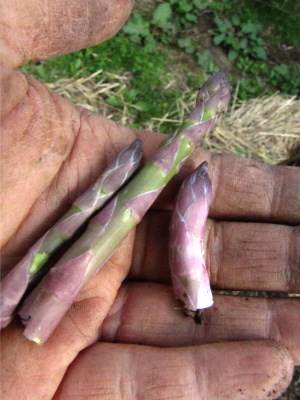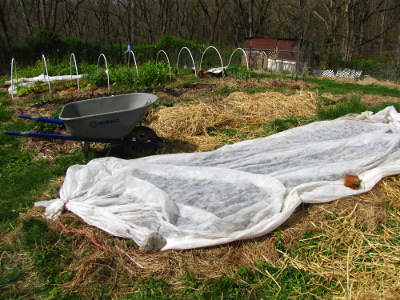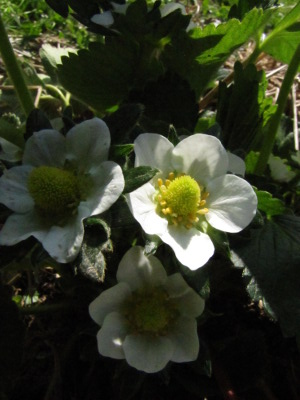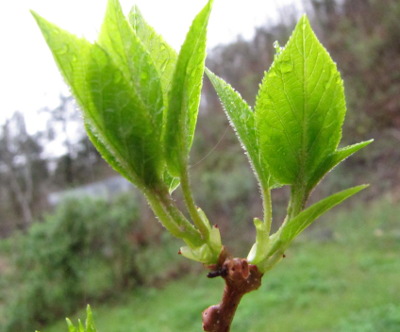
Quick garden frost protection
 It was hard to believe in
Monday night's frost warning as Mark and I worked outside in t-shirts
on a sunny, 60 degree afternoon. But we live down in a valley, so
when the weather forecast predicts a low of 35, I figure it will
probably freeze. Luckily, it's going to warm back up today and
then stay above freezing for the rest of the week, so I could get away
with quick and dirty frost protection.
It was hard to believe in
Monday night's frost warning as Mark and I worked outside in t-shirts
on a sunny, 60 degree afternoon. But we live down in a valley, so
when the weather forecast predicts a low of 35, I figure it will
probably freeze. Luckily, it's going to warm back up today and
then stay above freezing for the rest of the week, so I could get away
with quick and dirty frost protection.
The first step in
protecting your garden from cold is to take care of the low hanging
fruit. Asparagus spears are frost sensitive, so go pick anything
you've got and eat them for dinner. If you have seedlings in
flats hardening off outside, bring them in for the night.
Next, decide which
plants are going to have the most trouble. Cold tolerant plants
like lettuce, onions, and leafy greens will probably be okay as long as
you don't have a killing frost (below 25), but younger seedlings are
more sensitive. I chose to cover up my baby broccoli, cabbage,
lettuce, swiss chard, and arugula seedlings since they are all in the
cotyledon or one true leaf stage, but I left my onions (at least two
true leaves apiece) and all of the over-wintered greens alone.
 A lot of the seedlings I
chose to protect would have been under quick
hoops during a
normal spring, but it didn't seem worthwhile to erect the structures
when there were no frosts on the horizon. For just a few days,
row cover fabric draped over the plants and weighed down with rocks
works just fine. In fact, if you've only got one night of
predicted freezes, like we do this week, you can put just about
anything on the beds the night before and take them off once the frost
melts --- old sheets, blankets, filthy row cover fabric that doesn't
let light through anymore, tarps, upturned buckets, etc.
A lot of the seedlings I
chose to protect would have been under quick
hoops during a
normal spring, but it didn't seem worthwhile to erect the structures
when there were no frosts on the horizon. For just a few days,
row cover fabric draped over the plants and weighed down with rocks
works just fine. In fact, if you've only got one night of
predicted freezes, like we do this week, you can put just about
anything on the beds the night before and take them off once the frost
melts --- old sheets, blankets, filthy row cover fabric that doesn't
let light through anymore, tarps, upturned buckets, etc.
 Fruit plants are also
sensitive to spring frosts once they start to bloom. According to
my critical
temperature chart,
we shouldn't be in danger of losing any of our tree fruits as long as
the temperature stays above 28, which is a good thing because I haven't
had much luck swaddling
peach limbs to
protect the flowers in the past. If I had a small tree I really
cared about, I might fill a kiddie pool or a bunch of five gallon
buckets up with water, line the containers up around the base of the
tree, then throw a tarp over the whole thing. Or, maybe, leave
sprinklers running all night, but that would use a lot of water.
Fruit plants are also
sensitive to spring frosts once they start to bloom. According to
my critical
temperature chart,
we shouldn't be in danger of losing any of our tree fruits as long as
the temperature stays above 28, which is a good thing because I haven't
had much luck swaddling
peach limbs to
protect the flowers in the past. If I had a small tree I really
cared about, I might fill a kiddie pool or a bunch of five gallon
buckets up with water, line the containers up around the base of the
tree, then throw a tarp over the whole thing. Or, maybe, leave
sprinklers running all night, but that would use a lot of water.
My strawberries are
another matter. The plants in the front garden are shaded by the
hillside all winter and haven't started to bloom yet, but beds in the
most sunny part of the garden are coated in flowers. Even though
strawberries are sensitive (open blooms will be nipped at 30 degrees),
they're small enough to protect easily, so I rustled up some old row
cover fabric and weighed it down over the berry plants with bricks.
 The plants I'm most concerned
about are actually my hardy
kiwis. Despite
the name, I've found them to be quite sensitive to frost once they wake
up in the spring, and I'm afraid we might lose the current flush of
leaves. Last year, the kiwis were so small that Mark was able to
protect each plant under a five gallon bucket, but the vines have run
for several feet along the trellis wires since then. I couldn't
quite wrap my head around protecting the tender vines, so I guess we'll
just have to wait and see what happens.
The plants I'm most concerned
about are actually my hardy
kiwis. Despite
the name, I've found them to be quite sensitive to frost once they wake
up in the spring, and I'm afraid we might lose the current flush of
leaves. Last year, the kiwis were so small that Mark was able to
protect each plant under a five gallon bucket, but the vines have run
for several feet along the trellis wires since then. I couldn't
quite wrap my head around protecting the tender vines, so I guess we'll
just have to wait and see what happens.
Want more in-depth information? Browse through our books.
Or explore more posts by date or by subject.
About us: Anna Hess and Mark Hamilton spent over a decade living self-sufficiently in the mountains of Virginia before moving north to start over from scratch in the foothills of Ohio. They've experimented with permaculture, no-till gardening, trailersteading, home-based microbusinesses and much more, writing about their adventures in both blogs and books.
Want to be notified when new comments are posted on this page? Click on the RSS button after you add a comment to subscribe to the comment feed, or simply check the box beside "email replies to me" while writing your comment.

All my peach trees are in full bloom from the past few weeks of mild temps we had earlier this month. Since they are young I'm going to leave them alone. I was also just wondering about seed transplants yesturday and you post this haha. Good to know about how useful the agrifab is. Which agrifab do you use?
Also any tips on moving a peach/pear tree with about a 6" trunk? I assume at least a good 4' root-ball to be safe?
My late uncles plants are looking for new homes and I was hoping to take all the fruit trees (about a dozen) and setting them up along my fence in a Espalier/wall setup. I don't have a ton of room and think I can make them efficient and also be able to cover them in case easily with a roll of agrifab since they will be all trained to run along the fence. Any tips/ideas. Just brainstorming at the moment.
Marco --- We use agribon-19. What Eliot Coleman recommends is to use a very thin layer to protect your plants in the winter so it lets the maximum amount of light through. (This is in stark contrast to my gut reaction, which led me initially to get the heavier stuff, with less impressive results.)
Are we talking about a peach/pear tree with a trunk six inches in diameter? That's huge! I'm not sure you'll have good results without one of those fancy excavators, but one tip I've read for moving relatively large plants is to spend a year or two doing it. Figure out how big of a root mass you're willing to dig up, then sink your spade into the earth in a dashed line pattern around that perimeter. What you're trying to do is to cut through half the roots so that the tree will have to replace them with new feeder roots close to the trunk. The unsevered roots will feed the tree while it's growing the new roots. Several months or a year later, go back and cut another dashed line, this time severing the roots that didn't get cut last time. Wait another few months or a year. Then you're finally ready to dig up the tree --- it will have grown useful roots close enough to the trunk that it can survive the transplant.